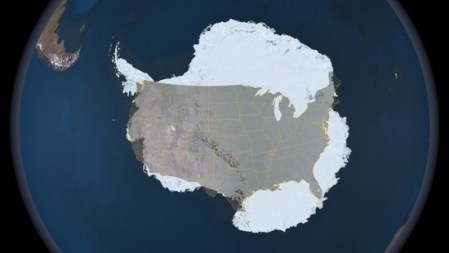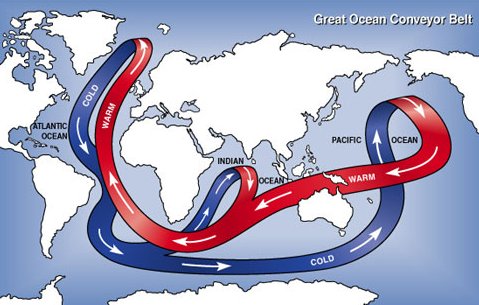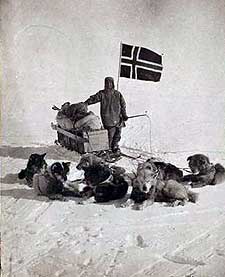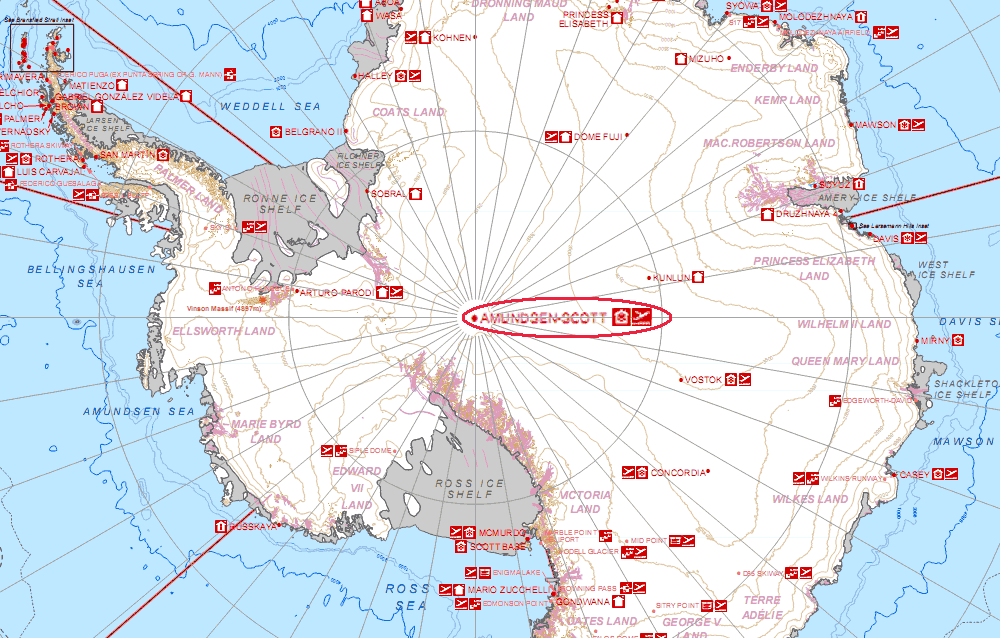CHAPTER 5
Well, let’s start off with a little refresher on Antarctica. Most of us have probably not thought about the continent since middle school geography class, so here are some interesting things to remember that will help give context and perspective to our life here at the South Pole…
Antarctica is the coldest, driest, highest, windiest, most desolate place on earth. It is the 5th largest continent, right behind South America, but ahead of Europe and Australia, and is almost one and a half times the size of the United States. Even though it is covered by a huge ice-sheet, more than two miles thick at its maximum, Antarctica is considered a desert due to an almost complete absence of precipitation. The ice covering the land mass and that extending out over the sea makes up about 90% of the world’s ice, and contains 70% of the world’s fresh water. If it was all to melt, global sea levels would rise more than 200ft.

Comparison of the US to Antarctica
The continent has a singular position on the earth, being directly at the bottom of the globe, and surrounded on all sides by the Southern Ocean. This one fact accounts for much of the world’s present climate and temperature. The Circumpolar Current, made of very cold water, circles the Southern Ocean, isolating Antarctica, keeping it cold and ice covered, while acting as a 05temperature regulator for the rest of the planet by sending cold water up to the tropics and receiving warm water in return. This exchange of cold and hot water is called the Great Ocean Conveyor, and drives all the world’s major ocean currents, in addition to providing much of the nutrients that make the base of the ocean food pyramid, in the form of microscopic phytoplankton, which bloom in the Southern Ocean and are carried north by currents.

The Great Ocean Conveyor
Interestingly, before Australia and then South America split off from Antarctica about 23 million years ago, the climate of Antarctica was much warmer (due to the lack of the Circumpolar Current) even though the continent was roughly in the same location as today. In this time period, the land would have been free of ice in large areas, covered with forests, and thriving with wildlife. Evidence has been found that as recently as 3 million years ago (that is within the age of humans), that an extensive temperate forest flourished only 400 miles from the South Pole. If Antarctica was not positioned where it is over the pole, or if other continents were somehow connected to it preventing the Circumpolar Current from forming, the world would definitely be a much warmer and different place.
Being that it is covered by ice right now, there are few animals that call Antarctica home. Penguins are the first that come to mind, but there are also a few other bird species, sea lions and seals, and not much else, at least on land. In the water there is understandably a much larger population starting with the smallest of microscopic plankton, to the biggest animals on earth- whales. Contrary to popular belief, there are no polar bears in Antarctica- they live at the North Pole. At the South Pole, there are no living creatures at all, except for us humans and the germs and bacteria we bring with us.
Considering how big Antarctica is, and how central a role it plays in the world climate and health of the oceans, it is incredible to learn that up until 1820 when the land of the continent was first actually sighted, the existence of the continent was little more than speculation based on ancient geographers’ desire to “balance” the earth with a large landmass in the Southern hemisphere, offsetting the apparent northern dominance by Asia, Europe and North Africa.
Even after these first intrepid explorers (and more often than not, greedy whalers) reached the icy shores of the continent, it took almost a century for man to grow the courage to mount expeditions to the interior of Antarctica, and for the first time, place their mark (in this case a Norwegian flag) at the bottom of the world- the South Pole.

Roald Amundsen at the South Pole, December 14, 1911
In modern times, Antarctica has become a beacon of global cooperation and diplomacy. The twelve original signees to the 1957 Antarctic Treaty agreed to preserve the continent for the sake of is unique and unspoiled environment, restricting use for peaceful scientific purposes. The most astonishing aspect of the treaty in my opinion is that these traditionally politically and ideologically opposed countries suppressed their greedy land-grabbing MOs and deiced that no one country should own Antarctica, much like the ocean- though most of the signees have made formal territorial claims (some overlapping) and the remainder have reserved the right to make a claim, should the treaty ever dissolve.

Map of permanent science bases in Antarctica
There are over 60 scientific bases and field camps on Antarctica run by half as many countries, most of which are fairly small, but the largest being the US’s McMurdo Station situated on Ross Island, almost directly south of New Zealand. McMurdo is the hub of all US operations in the continent due to its size, airfield capabilities, and ocean accessibility for resupply of fuel and equipment. To put things in perspective, McMurdo is host to about 1200 summertime residents, while the total Antarctic summertime population is an average of 4000. By contrast, the South Pole Station has a maximum summertime population of only 250.0
Being two of those 250 people, Kacey and I feel pretty darn lucky…
Prev ChapterNext Chapter